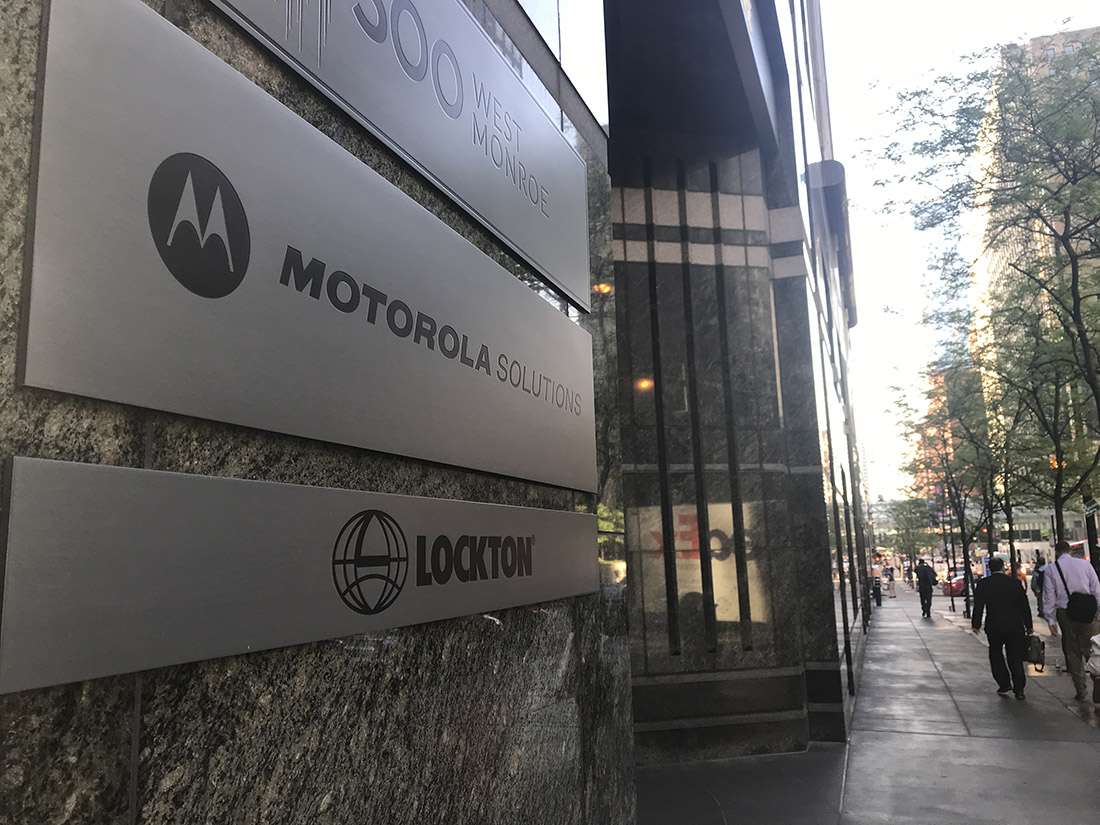By Sarah Foster
Medill Reports
The head of Motorola Solutions Inc. is reaping the financial benefits of leading a well-performing company, analysts and compensation experts said.
The company’s directors raised CEO Gregory Brown’s salary by 27 percent in 2017, a year when Motorola Solutions grew profits and adjusted income, completed multiple acquisitions and launched 85 new products, according to its most recent proxy statement, which was filed on March 28 with the U.S. Securities and Exchange Commission. Last year, Brown complemented a $1.25 million base salary with additional incentives worth $13.81 million, making his total compensation package $15.06 million, the statement said. The Chicago-based company provides telecommunications equipment for public safety officials.
Brown’s total compensation package has nearly doubled since 2014, when he received $7.61 million, according to the company’s 2014 proxy statement. At the same time, Motorola stock price has nearly doubled over the past three years as well, analysts said.
“He’s benefited just as much as shareholders have,” said Keith Housum, managing director and equity research analyst at Northcoast Research.
Brown’s pay raise in 2017 reflects the ideal structure of an executive compensation package, said Steve Kaplan, a professor at the University of Chicago Booth School of Business who specializes in corporate governance. When a company performs well, the CEO gets a raise. When the company performs poorly, the CEO makes less money. Brown belongs to the first scenario, Kaplan said.
“He is delivering,” Kaplan said. “And because he is delivering, he is getting paid.”
Based on Kaplan’s research, the average pay of a CEO at a publicly traded utility company on the Standard & Poor’s index is between $10 million and $15 million, making Brown’s compensation just slightly more than usual, he said.
“He outperformed, so it would be perfectly natural to pay him more,” Kaplan said.
Brown’s compensation package is based on a combination of short-term and long-term incentives that focus on raising the company stock price, outperforming the S&P 500, growing profits and sales, and increasing yearly dividends to shareholders, according to the proxy filing.
Motorola increased its income for the full-year 2017 by 6 percent to $6.4 billion, compared with $6 billion a year earlier, according to the company’s earnings release. Earnings under generally accepted accounting principles, however, fell by $155 million last year, due to a one-time tax charge of $1.2 billion under U.S. tax reform. Excluding this charge, earnings increased by 27 percent to $1.1 billion, compared with $844 million a year ago, the release said.
Motorola also repurchased $483 million of stock last year and paid dividends of $307 million to shareholders, according to the company’s proxy statement. The company’s total shareholder return, which includes stock price increases and regular payments of dividends over a year-long period, is 44 percent, while the S&P 500 is 38 percent, the proxy said. Outperforming the S&P 500 index is one of Brown’s long-term pay incentives.
It’s good that Motorola Solutions includes outperforming the S&P 500 as a long-term pay goal, said Robert Wiseman, senior associate dean at the Eli Broad College of Business at Michigan State University who specializes in executive compensation and corporate governance. When the market generally goes up, so do most stock prices, and consequently, shareholder returns, he said. When returns are compared to an index, it more accurately represents how well a company is performing, he said.
“If the general market goes up like we saw last year, the stock just goes up with the market,” Wiseman said. “It at least shows that this person is driving value independent of the market’s valuation of companies across the board.”
Acquisitions have caused the company’s stock price to increase, Fitzsimmons said. Motorola invested $298 million in acquisitions last year, according to the company’s proxy statement. One of these acquisitions closed in August, when Motorola Solutions acquired Kodiak Networks, a broadband push-to-talk service provider.
“Motorola Solutions is in the midst of a product transformation,” Fitzsimmons said. “I think that’s manifested itself in the stock price of the company the past couple of years.”
An investment agreement with a private equity firm has also impacted the CEO’s compensation package, Fitzsimmons said. Silver Lake Partners invested $1 billion in Motorola Solutions in 2015 and obtained two seats on the board, said Chris Kutsor, vice president of investor relations at Motorola Solutions.
After the investment, board members established a new performance metric system. The board will grant executives more stock options if the company achieves certain stock prices by Aug. 25. The first hurdle, reaching a stock price of $85, and the second hurdle, reaching a stock price of $102.50, have already been achieved. The third hurdle — $120 — has not yet been met, but it likely will be soon, Housum said.
“His compensation will probably be up significantly above his $15 million in 2017,” Housum said. “$15 million may seem quite small in comparison.”
It’s not entirely unusual for private equity firms to invest in publicly traded companies, Kaplan said, but it does add more pressure on the CEO.
“That private equity firm makes money only if the company does well,” Kaplan said. “And any money that they pay to the CEO means they make less money. They’re not going to be overpaying the CEO.”
Nonetheless, Fitzsimmons said he is comfortable with these upward trends in Brown’s pay package. It isn’t out of line, he said.
“Motorola is a company that has hit those financial targets over the past four years,” he said. “The compensation package makes sense when you consider the return he’s been able to give to investors.”

